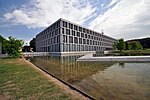Erfurt–Weimar Airport
Airports in ThuringiaBuildings and structures in ThuringiaErfurtPages with disabled graphs

Erfurt–Weimar Airport (German: Flughafen Erfurt–Weimar, formerly Erfurt Airport, IATA: ERF, ICAO: EDDE) serves Erfurt, the capital of the German state of Thuringia, and the nearby city of Weimar, both of which form the largest part of the state's central metropolitan area. The airport is 5 km (3.1 mi) west of Erfurt city center and is mainly used for seasonal charter flights to European leisure destinations.
Excerpt from the Wikipedia article Erfurt–Weimar Airport (License: CC BY-SA 3.0, Authors, Images).Erfurt–Weimar Airport
Binderslebener Landstraße, Erfurt
Geographical coordinates (GPS) Address Phone number Website External links Nearby Places Show on map
Geographical coordinates (GPS)
| Latitude | Longitude |
|---|---|
| N 50.979722222222 ° | E 10.958055555556 ° |
Address
Flughafen Erfurt-Weimar
Binderslebener Landstraße 100
99092 Erfurt
Thuringia, Germany
Open on Google Maps










